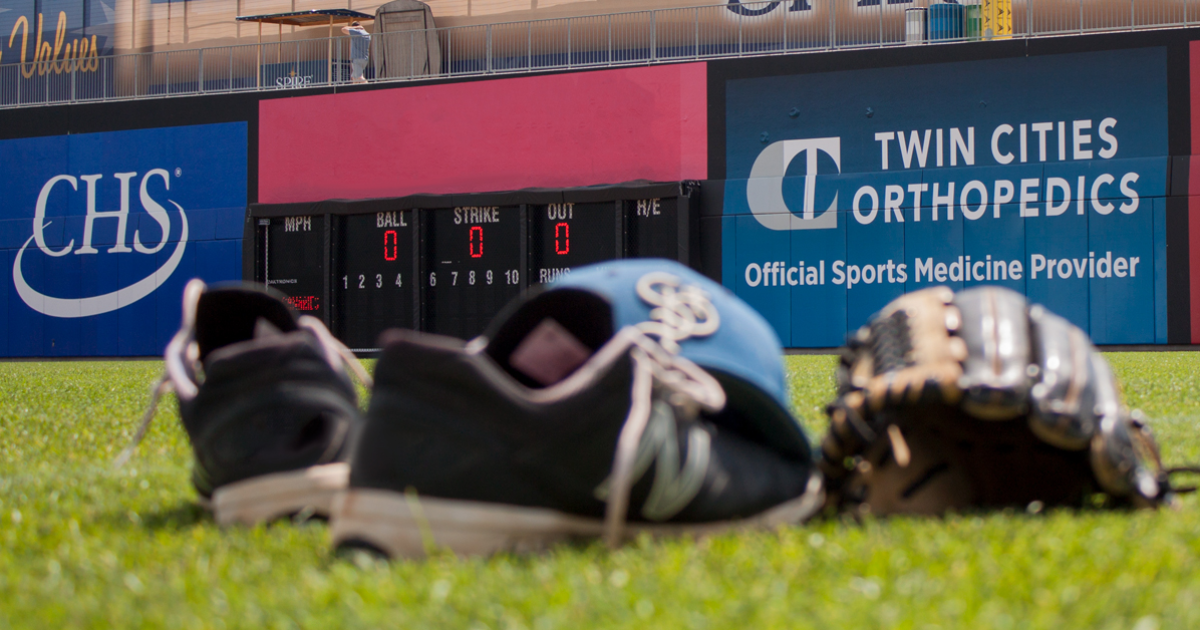
September 7, 2017 - TCO
Ballpark Basics: Lessons from the pros
Growing up many of us watched professional baseball players with envy as they made incredible plays, achieved unbelievable milestones, and left it all out on the field. We wanted to play like them so we emulated their swings and re-enacted their highlights. We wanted to act like them, so we bought their merchandise and played video games with their names on them. Most importantly, we wanted to BE them when we grew up.
Then, we grew up. And can you believe it? We’re not professional baseball players. But we are parents, coaches, and athletes in our own right who can still learn a thing or two from the pros.
Since their inception in 1993, orthopedic surgeons from Twin Cities Orthopedics (formerly St. Croix Orthopaedics) have volunteered their time as team physicians for the St. Paul Saints baseball team. Today, TCO physicians Dr. Andrea Saterbak and Dr. Steven Meisterling dedicate time to diagnosing injuries, providing sports medicine and injury prevention oversight, and occasionally performing surgery when necessary. Their full medical team includes Jason Ellenbecker, head athletic trainer for the team who provides the majority of day-to-day care of the athletes, as well as Dr. Nicholas Weiss, Dr. Jason Dieterle and Dr. Nicholas Holmes, who provide additional support when called upon.
It’s an honor to be a longtime partner of the Saints, and we’re excited to share some lessons we’ve learned along the way. Share these tips with your children, coaches, and parents of young athletes, and maybe they’ll end up being just like the pros after all.
Don’t be sloppy.
If you watch the Saints players warm up, they’re doing it the same methodical way they’ve been doing it since Little League. They start with close-range soft toss then gradually work to longer throwing distances. And most importantly, they take every throw seriously. All it takes is one moment of sloppiness, usually caused by fatigue, to result in injury. Dr. Meisterling recommends dynamic warm-up exercises as opposed to static stretching in order to get the body ready to perform.
Focus on your strengths.
When you work with the Saints, you quickly realize how well the players understand their bodies. Over time they’ve learned to focus on their strengths, and spend less time trying to overcorrect weaknesses. They recognize the weaknesses that may lead to overuse injuries and look to carefully shift the patterns of movements that can then blend and complement their strengths. As Dr. Saterbak points out, players at all levels need to listen to their bodies. The same way that everyone has unique throwing motions or swings, everyone reacts to injury differently. One player’s sore elbow is another player’s injury warning.
As you ramp up into your sport’s season, turn down the overtraining and focus on refining skills, not bulking up. Then, during the offseason, Dr. Meisterling recommends cross-training and playing multiple sports year-round, as opposed to focusing on one single sport. Playing different sports exercises different muscles, resulting in reduced injury risk and improved overall athleticism.
Talk to the experts.
First of all, trust the qualified sports medicine professionals in your life. Whether it’s a team athletic trainer or a physical therapist helping you return from injury, he or she is there to be a resource and help bring out your best. Listen to them and trust their guidance, just like the pros. As Dr. Saterbak points out, the professional-level players are managed for bullpen time and their spot in the pitching rotation, but despite all of the injury prevention protocols in place the players know that if something feels even slightly off that they should talk to the medical team right away.
Parents, coaches, and players should be aware that shoulder- and elbow-overuse injuries are the most prevalent in baseball and softball, especially amongst young players. For younger athletes there are guidelines for managing pitch counts to help guide how much is too much, while the Stop Sports Injuries website is another great resource for learning to prevent overuse injuries.
Of course, if you are hurt, or if you suspect your child may be injured, don’t wait to get it checked out. Our Orthopedic Urgent Care clinics are open 8am-8pm daily at 8 convenient metro locations to make sure you’re treated the right way – by an expert – from the beginning.
Remember to have fun!
At the professional level, mental acuity is paramount and morale is huge. In fact, while we were sitting in the Saints dugout talking to Dr. Saterbak, coach George Tsamis overheard the conversation and chimed in, “The clubhouse is everything.” It’s true that in sports, especially baseball and softball, the mental game is just as important as the physical one. Whether it’s staying motivated during a struggling slump, or being patient while returning from injury, players at all levels should lean on their teammates, family, coaches, and medical team to help them stay positive and approach each new season, game, and at-bat with excitement and confidence.
At the pro level they talk about morale, the clubhouse, camaraderie, and the mood in the dugout. But if you think about it, that’s just another way of saying that no matter what level you’re playing at, the game is meant to be fun. Perfect, since it’s the Saints’ motto: Fun Is Good.

